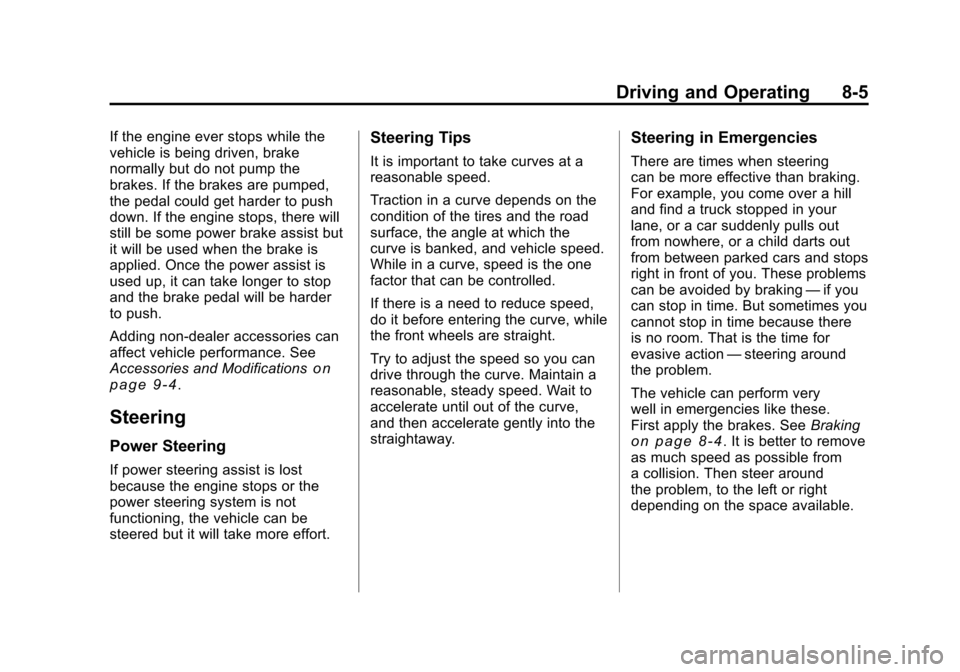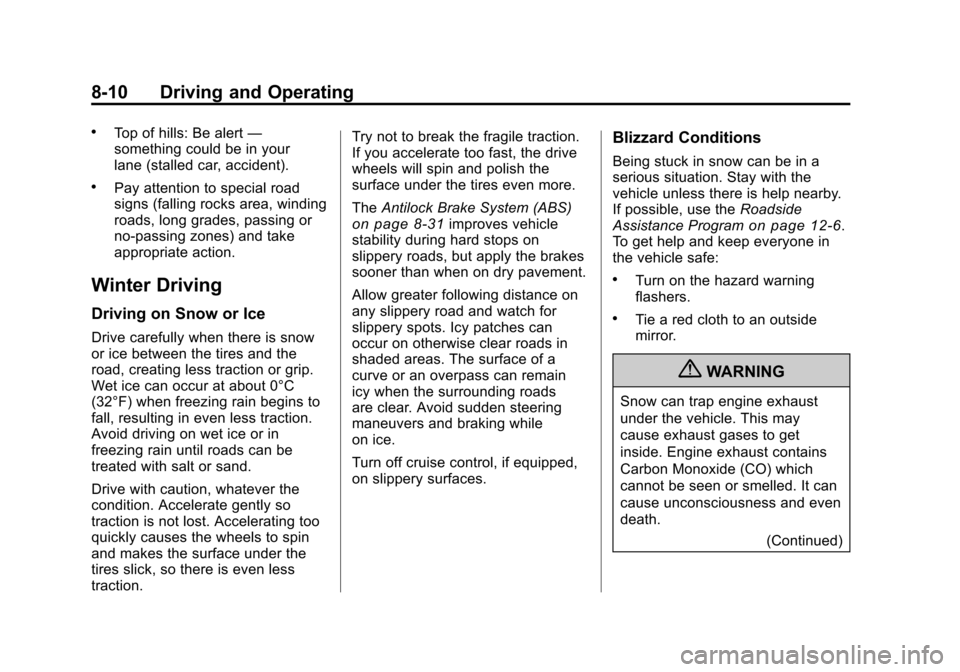2010 CHEVROLET CAMARO lane assist
[x] Cancel search: lane assistPage 181 of 378

Black plate (5,1)Chevrolet Camaro Owner Manual - 2010
Driving and Operating 8-5
If the engine ever stops while the
vehicle is being driven, brake
normally but do not pump the
brakes. If the brakes are pumped,
the pedal could get harder to push
down. If the engine stops, there will
still be some power brake assist but
it will be used when the brake is
applied. Once the power assist is
used up, it can take longer to stop
and the brake pedal will be harder
to push.
Adding non‐dealer accessories can
affect vehicle performance. See
Accessories and Modifications
on
page 9‑4.
Steering
Power Steering
If power steering assist is lost
because the engine stops or the
power steering system is not
functioning, the vehicle can be
steered but it will take more effort.
Steering Tips
It is important to take curves at a
reasonable speed.
Traction in a curve depends on the
condition of the tires and the road
surface, the angle at which the
curve is banked, and vehicle speed.
While in a curve, speed is the one
factor that can be controlled.
If there is a need to reduce speed,
do it before entering the curve, while
the front wheels are straight.
Try to adjust the speed so you can
drive through the curve. Maintain a
reasonable, steady speed. Wait to
accelerate until out of the curve,
and then accelerate gently into the
straightaway.
Steering in Emergencies
There are times when steering
can be more effective than braking.
For example, you come over a hill
and find a truck stopped in your
lane, or a car suddenly pulls out
from nowhere, or a child darts out
from between parked cars and stops
right in front of you. These problems
can be avoided by braking —if you
can stop in time. But sometimes you
cannot stop in time because there
is no room. That is the time for
evasive action —steering around
the problem.
The vehicle can perform very
well in emergencies like these.
First apply the brakes. See Braking
on page 8‑4. It is better to remove
as much speed as possible from
a collision. Then steer around
the problem, to the left or right
depending on the space available.
Page 185 of 378

Black plate (9,1)Chevrolet Camaro Owner Manual - 2010
Driving and Operating 8-9
Other Rainy Weather Tips
Besides slowing down, other wet
weather driving tips include:
.Allow extra following distance.
.Pass with caution.
.Keep windshield wiping
equipment in good shape.
.Keep the windshield washer fluid
reservoir filled.
.Have good tires with proper
tread depth. SeeTireson
page 9‑49.
.Turn off cruise control.
Highway Hypnosis
Always be alert and pay attention
to your surroundings while driving.
If you become tired or sleepy, find
a safe place to park your vehicle
and rest.
Other driving tips include:
.Keep the vehicle well ventilated.
.Keep interior temperature cool.
.Keep your eyes moving —scan
the road ahead and to the sides.
.Check the rearview mirror and
vehicle instruments often.
Hill and Mountain Roads
Driving on steep hills or through
mountains is different than driving
on flat or rolling terrain. Tips for
driving in these conditions include:
.Keep the vehicle serviced and in
good shape.
.Check all fluid levels and brakes,
tires, cooling system, and
transmission.
.Shift to a lower gear when going
down steep or long hills.
{WARNING
If you do not shift down, the
brakes could get so hot that they
would not work well. You would
then have poor braking or even
(Continued)
WARNING (Continued)
none going down a hill. You could
crash. Shift down to let the engine
assist the brakes on a steep
downhill slope.
{WARNING
Coasting downhill in N (Neutral)
or with the ignition off is
dangerous. The brakes will have
to do all the work of slowing down
and they could get so hot that
they would not work well. You
would then have poor braking
or even none going down a hill.
You could crash. Always have the
engine running and the vehicle in
gear when going downhill.
.Stay in your own lane. Do not
swing wide or cut across the
center of the road. Drive at
speeds that let you stay in
your own lane.
Page 186 of 378

Black plate (10,1)Chevrolet Camaro Owner Manual - 2010
8-10 Driving and Operating
.Top of hills: Be alert—
something could be in your
lane (stalled car, accident).
.Pay attention to special road
signs (falling rocks area, winding
roads, long grades, passing or
no-passing zones) and take
appropriate action.
Winter Driving
Driving on Snow or Ice
Drive carefully when there is snow
or ice between the tires and the
road, creating less traction or grip.
Wet ice can occur at about 0°C
(32°F) when freezing rain begins to
fall, resulting in even less traction.
Avoid driving on wet ice or in
freezing rain until roads can be
treated with salt or sand.
Drive with caution, whatever the
condition. Accelerate gently so
traction is not lost. Accelerating too
quickly causes the wheels to spin
and makes the surface under the
tires slick, so there is even less
traction. Try not to break the fragile traction.
If you accelerate too fast, the drive
wheels will spin and polish the
surface under the tires even more.
The
Antilock Brake System (ABS)
on page 8‑31improves vehicle
stability during hard stops on
slippery roads, but apply the brakes
sooner than when on dry pavement.
Allow greater following distance on
any slippery road and watch for
slippery spots. Icy patches can
occur on otherwise clear roads in
shaded areas. The surface of a
curve or an overpass can remain
icy when the surrounding roads
are clear. Avoid sudden steering
maneuvers and braking while
on ice.
Turn off cruise control, if equipped,
on slippery surfaces.
Blizzard Conditions
Being stuck in snow can be in a
serious situation. Stay with the
vehicle unless there is help nearby.
If possible, use the Roadside
Assistance Program
on page 12‑6.
To get help and keep everyone in
the vehicle safe:
.Turn on the hazard warning
flashers.
.Tie a red cloth to an outside
mirror.
{WARNING
Snow can trap engine exhaust
under the vehicle. This may
cause exhaust gases to get
inside. Engine exhaust contains
Carbon Monoxide (CO) which
cannot be seen or smelled. It can
cause unconsciousness and even
death.
(Continued)
Page 377 of 378

Black plate (11,1)Chevrolet Camaro Owner Manual - 2010
INDEX i-11
Tires (cont.)If a Tire Goes Flat . . . . . . . . . . . . 9-71
Inflation Monitor System . . . . . . 9-60
Inspection . . . . . . . . . . . . . . . . . . . . 9-63
Messages . . . . . . . . . . . . . . . . . . . . 4-36
Pressure . . . . . . . . . . . . . . . . . . . . . . 9-58
Pressure Light . . . . . . . . . . . . . . . . 4-26
Pressure Monitor System . . . . . 9-58
Rotation . . . . . . . . . . . . . . . . . . . . . . 9-63
Sealant and
Compressor Kit . . . . . . . . . . . . . 9-73
Sealant and Compressor Kit, Storing . . . . . . . . . . . . . . . . . . 9-79
Sidewall Labeling . . . . . . . . . . . . . 9-50
Terminology and
Definitions . . . . . . . . . . . . . . . . . . . 9-53
Uniform Tire Quality Grading . . . . . . . . . . . . . . . . . . . . . 9-67
Wheel Alignment and Tire Balance . . . . . . . . . . . . . . . . . . . . . 9-69
Wheel Replacement . . . . . . . . . . 9-69
When It Is Time for New Tires . . . . . . . . . . . . . . . . . . . . . . . . 9-64
Winter . . . . . . . . . . . . . . . . . . . . . . . . 9-49 Towing
Driving Characteristics . . . . . . . . 8-49
Equipment . . . . . . . . . . . . . . . . . . . . 8-55
General Information . . . . . . . . . . 8-48
Recreational Vehicle . . . . . . . . . . 9-90
Trailer . . . . . . . . . . . . . . . . . . . . . . . . 8-53
Vehicle . . . . . . . . . . . . . . . . . . . . . . . 9-90
Traction . . . . . . . . . . . . . . . . . . . . . . . . 4-25 Control OFF/StabiliTrakOFF Light . . . . . . . . . . . . . . . . . . . 4-25
Control System (TCS) . . . . . . . . 8-34
Control System (TCS)/
StabiliTrak
®Light . . . . . . . . . . . . 4-25
Limited-Slip Rear Axle . . . . . . . . 8-38
Off Light . . . . . . . . . . . . . . . . . . . . . . 4-24
Trailer Towing . . . . . . . . . . . . . . . . . 8-53
Transmission
Automatic . . . . . . . . . . . . . . . . . . . . . 8-26
Fluid, Automatic . . . . . . . . . . . . . . 9-14
Fluid, Manual . . . . . . . . . . . . . . . . . 9-14
Messages . . . . . . . . . . . . . . . . . . . . 4-37
Temperature Gauge . . . . . . . . . . 4-16 Transportation Program,
Courtesy . . . . . . . . . . . . . . . . . . . . . 12-8
Trip Odometer . . . . . . . . . . . . . . . . . 4-12
Trunk . . . . . . . . . . . . . . . . . . . . . . . . . . . 1-8
Turn and Lane-Change Signals . . . . . . . . . . . . . . . . . . . . . . . . 5-5
U
Ultrasonic Parking Assist . . . . . . 8-41
Uniform Tire QualityGrading . . . . . . . . . . . . . . . . . . . . . . 9-67
Universal Remote System . . . . . 4-44 Operation . . . . . . . . . . . . . . . . . . . . . 4-47
Programming . . . . . . . . . . . . . . . . . 4-44
Using this Manual . . . . . . . . . . . . . . . . iv